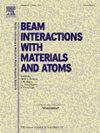L-subshell production cross sections of Lu and Hf by 10 keV-30 keV electron bombardment
IF 1.4
3区 物理与天体物理
Q3 INSTRUMENTS & INSTRUMENTATION
Nuclear Instruments & Methods in Physics Research Section B-beam Interactions With Materials and Atoms
Pub Date : 2025-03-01
DOI:10.1016/j.nimb.2025.165668
引用次数: 0
Abstract
The L-subshell X-ray production cross sections (XRPCSs) were measured for the heavy elements Lu (Z = 71) and Hf (Z = 72) induced by the bombardment of single-energy electron beams of 10 keV-30 keV. The generated X-ray spectra from the thin targets with thick carbon substrates were collected using a silicon drift detector. Corrections for excess X-rays, arising from electron multiple scattering, bremsstrahlung and backscattered electrons from the thick substrates, were performed using Monte Carlo simulations. The experimental results were compared with theoretical values based on the distorted-wave Born approximations and two sets of atomic relaxation parameters. Overall, the experimental XRPCSs of Lu and Hf are closer to the theoretical values based on the fluorescence yields and Coster-Kroning probabilities from Dirac-Hartree-Slater (DHS) calculations and emission rates from Dirac-Fock (DF) calculations within the experimental and theoretical uncertainties in the entire incident electron energy region.
10kv - 30kev电子轰击Lu和Hf的l -亚壳生成截面
本文测量了重元素Lu (Z = 71)和Hf (Z = 72)在10kv - 30kev单能电子束轰击下的l亚壳层x射线生成截面(XRPCSs)。利用硅漂移检测器收集了厚碳衬底薄靶产生的x射线光谱。利用蒙特卡罗模拟对电子多重散射、轫致辐射和厚衬底背散射电子产生的过量x射线进行了修正。基于畸变波玻恩近似和两组原子弛豫参数,将实验结果与理论值进行了比较。总体而言,在整个入射电子能量区域的实验和理论不确定度范围内,基于dirac - harree - slater (DHS)计算的荧光产率和Coster-Kroning概率以及Dirac-Fock (DF)计算的发射率,Lu和Hf的实验xrpss更接近理论值。
本文章由计算机程序翻译,如有差异,请以英文原文为准。
求助全文
约1分钟内获得全文
求助全文
来源期刊
CiteScore
2.80
自引率
7.70%
发文量
231
审稿时长
1.9 months
期刊介绍:
Section B of Nuclear Instruments and Methods in Physics Research covers all aspects of the interaction of energetic beams with atoms, molecules and aggregate forms of matter. This includes ion beam analysis and ion beam modification of materials as well as basic data of importance for these studies. Topics of general interest include: atomic collisions in solids, particle channelling, all aspects of collision cascades, the modification of materials by energetic beams, ion implantation, irradiation - induced changes in materials, the physics and chemistry of beam interactions and the analysis of materials by all forms of energetic radiation. Modification by ion, laser and electron beams for the study of electronic materials, metals, ceramics, insulators, polymers and other important and new materials systems are included. Related studies, such as the application of ion beam analysis to biological, archaeological and geological samples as well as applications to solve problems in planetary science are also welcome. Energetic beams of interest include atomic and molecular ions, neutrons, positrons and muons, plasmas directed at surfaces, electron and photon beams, including laser treated surfaces and studies of solids by photon radiation from rotating anodes, synchrotrons, etc. In addition, the interaction between various forms of radiation and radiation-induced deposition processes are relevant.

 求助内容:
求助内容: 应助结果提醒方式:
应助结果提醒方式:


